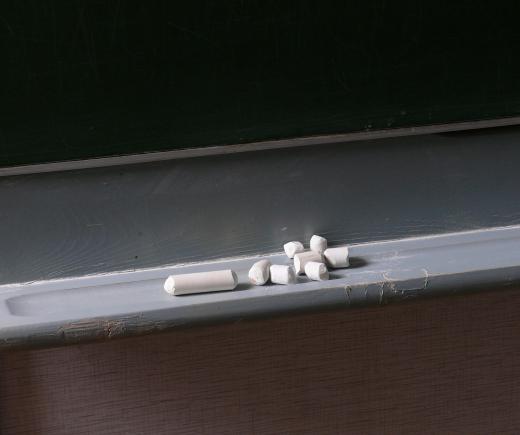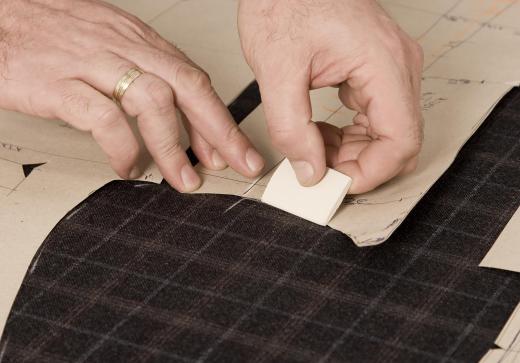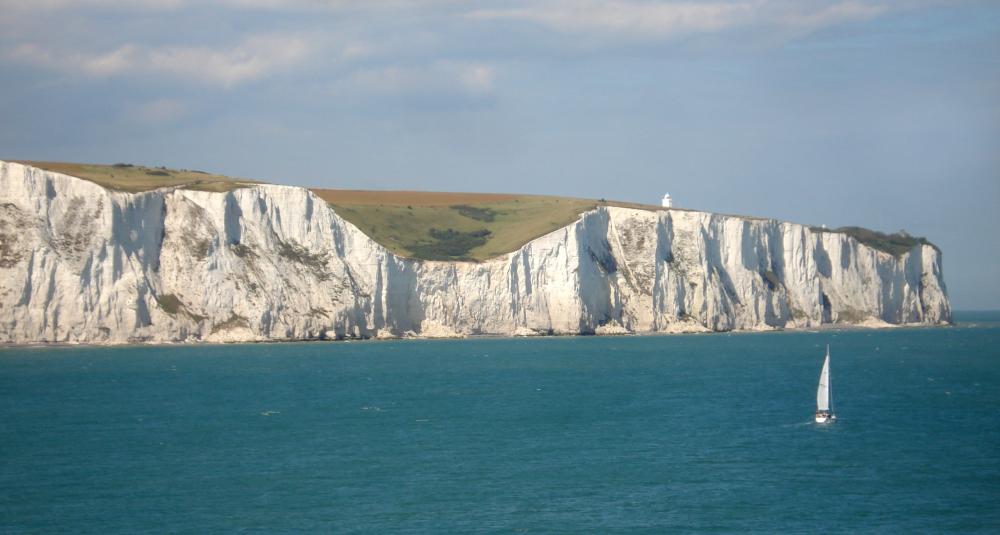At AllThingsNature, we're committed to delivering accurate, trustworthy information. Our expert-authored content is rigorously fact-checked and sourced from credible authorities. Discover how we uphold the highest standards in providing you with reliable knowledge.
What is Chalk?
Chalk is a form of limestone that is distinguished by its relative purity and close, fine grain. Humans have been using it for a variety of tasks for centuries, taking advantage of its properties for things like writing on blackboards, marking out fabric patterns for cutting, and delineating game fields in sports like tennis and American football. This mineral is extremely abundant, and it is widely quarried all over the world.
The chemical formula for chalk is CaCO3. Its primary ingredient is ancient fossilized sea organisms, which were deposited and subjected to high pressure over centuries, so deposits often occur in areas that were once underwater. Rocks that form through the deposition of sediments and other materials are known as sedimentary rocks; chalk is probably one of the most well known examples of this type of rock, thanks to its common use. Impurities like quartz, feldspar, and silica are often found in the deposits.

Although people often think of chalk as a very soft mineral, it is in fact remarkably resistant to weathering. This trait led to the formation of the famous White Cliffs of Dover, as the elements wore away at other mineral materials in the large limestone deposit that streaks across much of Europe, leaving imposing deposits of chalk in the form of cliffs and sea stacks behind. The mineral is also very porous, and it tends to store groundwater extremely well, releasing it during drier periods.

The natural mineral can range in color from yellow to gray to white, depending on the impurities it contains. Depending on what it is going to be used for, it may be treated to remove impurities and refined so that it turns white. It can also be dyed with various coloring agents to produce things like sidewalk chalk.
Most classroom chalk today is not actually made from limestone, but rather from various other mineral composites. The powdered material that was once used to mark out sports fields has also since been replaced by various other minerals or paint. It is still possible to find a few commercial products made from chalk, and many natural history museums keep it on display since it is a mineral of interest to many people.
Frequently Asked Questions
What is chalk made of?

Chalk is composed primarily of calcium carbonate (CaCO3), a type of limestone that originates from the accumulated remains of microscopic marine organisms called coccolithophores. These organisms flourished in the oceans millions of years ago, and their skeletal remains settled to the sea floor, forming thick deposits that eventually became the chalk we use today.
How is chalk formed?

Chalk formation is a geological process that took place over millions of years. As coccolithophores died, their calcium carbonate shells sank to the bottom of shallow seas, creating sediments. Over time, these sediments were compacted and solidified into chalk beds under layers of additional sediments, a process known as lithification.
Where can chalk be found?

Chalk deposits are predominantly found in areas that were once covered by ancient seas. Notable locations include the White Cliffs of Dover in England, parts of France, and the United States. These regions provide evidence of the extensive marine environments that existed during the Cretaceous period when chalk formation was at its peak.
What are the uses of chalk?
Chalk has a variety of uses, from educational tools in classrooms to sports like gymnastics and rock climbing for grip. It's also used in agriculture to raise soil pH, in manufacturing as a filler in plastics and paints, and even in medicine as an antacid. Its versatility stems from its easy-to-crush nature and absorbent properties.
Is chalk still used in classrooms today?
While chalk was once the standard for classroom teaching, its use has declined with the advent of whiteboards and digital technology. However, it remains in use in some educational settings due to its cost-effectiveness and low-tech appeal. Chalkboards also offer a tactile experience that some educators and artists still prefer.
Are there environmental concerns associated with chalk?
Chalk mining can have environmental impacts, such as landscape alteration and habitat destruction. However, compared to other mineral extractions, chalk's softness allows for less invasive mining techniques. Responsible management and restoration efforts can mitigate negative effects, ensuring that chalk remains a sustainable resource.
AS FEATURED ON:
AS FEATURED ON:















Discussion Comments
Be aware that if you give your child chalk as a gift, you may have to sacrifice your garage floor for awhile. I gave my niece a box of colored chalk for her fourth birthday while she was staying with me for a week, and I had to give up my parking spot so that she could work on her art project!
I remember finding a thick piece of yellow chalk in my friend's attic. We used that chalk to draw out hopscotch boxes on the sidewalk, and we had so much fun!
My friend's grandmother had been a schoolteacher, and she had recently passed away. The family had gotten a lot of her old stuff, and they just stored it all in the attic. We had been curious about what was up there, and when we found that chunk of chalk, it was like gold to us!
We didn't have a lot of toys, because our parents were poor. It's amazing how much one piece of chalk lit up our lives!
@claire24 – If the chalk is dustless, it isn't bad for kids at all. The dust is what causes respiratory problems for some kids, especially those prone to asthma attacks.
Also, if you have a computer in the room, the dust from the chalk can accumulate in it and cause it to overheat. It's safer just to use dustless chalk or a marker on an erasable board.
@golf07 – That chalk dust was really irritating to me, because I have issues with allergies and asthma. If I had to erase something that was on the blackboard, I would begin wheezing and start coughing.
Any kind of irritant that floats around in the air like that can get into your lungs and cause problems. Chalk dust was so fine that I easily inhaled it without trying to, and I would suffer for the rest of the period. This is why I never sat near the blackboard.
And what is the best part of all is that you can do art on the street and not have it be permanent. I always loved that about chalk. It can make such an impact but also be completely temporary.
My kids like to use the Crayola drawing chalk. They don't use this on chalkboards, but draw with it on paper. Once they get too old to use crayons, the colored chalk is a fun alternative for them.
They do make dustless chalk which does cut down quite a bit on the mess. My friends and I always enjoyed the job of cleaning the erasers. We got to leave the classroom and go outside for awhile.
They are always disappointed when the rain erases their artwork, but this just gives them reason to be creative all over again.
I find it hard to resist just watching them when they are playing with the sidewalk chalk. There is something relaxing and fun about making designs and patterns on the sidewalk with big, brightly colored pieces of chalk.
The chalk always left a residue on the board and on the erasers. It was quite a messy job to clean the erasers because the chalk dust would fly everywhere.
I have always liked to collect rocks. I remember that when I was a child, I sometimes found rocks that I could draw on the driveway with. I remember thinking that these rocks were just like chalk. Now I'm thinking that they might actually have been deposits of natural chalk!
I would love to see the White Cliffs of Dover. I didn't know that they were actually formed out of chalk deposits. I always think of chalk as being such a soft material. It's hard to imagine cliffs being made out of it.
Is this natural chalk harder than what we would use for making chalk drawings, or is it the same? If you step on a piece of chalk, it breaks very easily. Although larger sidewalk chalk seems a bit more durable. Maybe that's how cliffs can be formed out of it -- the more there is, the stronger it becomes?
I found this to be absolutely fascinating! I never knew that chalk was made from limestone and ancient sea creatures.
Why is blackboard chalk that is used in schools and on sporting fields made mostly from other mineral composites now, if natural chalk is so abundant? And is it true that sidewalk chalk made for children is not made from natural chalk anymore either? Is there something bad about natural chalk that would make it a poor choice for use with children?
I always like to use natural things when possible. So if there's nothing bad about natural chalk, I would like to find a place that sells chalk for kids that is made naturally.
Post your comments